20 January 2011
A review of the Brazil landslides – Nova Friburgo
Posted by Dave Petley
The lack of posts on this blog will not have passed unnoticed I am sure, and I can only apologise. Unfortunately, my day job is insanely busy at the moment, and I have no time for research, let alone blog posts. This will ease within a fortnight, if not before, so please be assured that the blog is not on the way to oblivion.
During my unfortunate lull in posts an extraordinary landslide disaster has of course unfolded in Brazil, killing at least 700 people, and possibly more than a thousand. The trigger has been very heavy rainfall associated with the current La Nina conditions, although the underlying cause is likely to be a combination of people living in the wrong places and damage to the environment as a result of human activities. The epicentre has been the three towns of Nova Friburgo, Teresopolis and Petropolis, located to the north of Rio de Janeiro. So let’s take a look at Nova Friburgo.
This is the Google Earth perspective view (dated March 2009) of Nova Friburgo – it is interesting because the landscape is not particularly high, though it is steep, and there are surprisingly few fresh landslide scars:
Inevitably the news reports and photos have focussed on the damage caused by the disaster rather than on the causes, but these news images are helpful:
 Source: AP
Source: AP
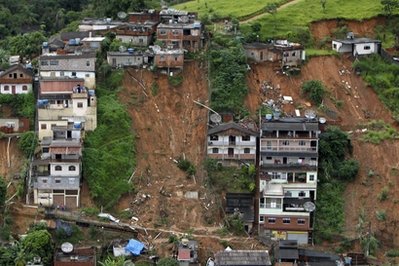 Source: AP
Source: AP
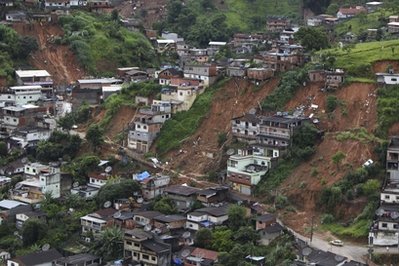 Source: AP
Source: AP
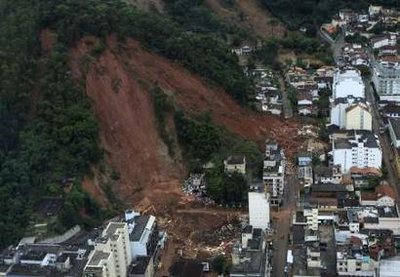 Source: Reuters
Source: Reuters
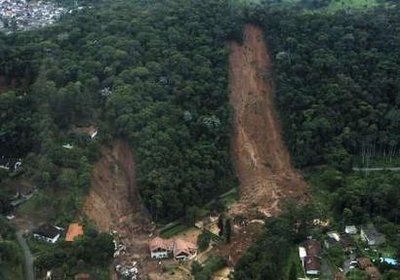 Source: Reuters
Source: Reuters
The news images tell us a fair amount about the landslides in Nova Friburgo at least. First, there are many (perhaps not surprising). Second, there appears to be two types of accidents occurring here. Some of the losses have been caused by direct hots by the landslides themselves. Most of these slides are long and narrow, extending most of the way up the slope. In rainfall induced landslides this is characteristic of failures that involve static liquefaction, which leads to rapid failure and high rates of movement. This is supported by the second to last image, in which the runout distance of the debris at the foot of the slope is quite long. It is unsurprising that the loss of life has been so high in areas affected by such slides. The second type is indicated by the very first image, which suggests multiple flow-type landslides in close proximity. Note here that the slides are both large and in some cases quite deep. However, there is almost no debris accumulated at the toe of the slopes, suggesting that it has moved rapidly down the watercourse. It is likely to have been this mechanism that created the devastating debris and mud flows that caused so much damage downstream.
There is also a rather impressive set of images of the disaster on this presentation (unfortunately I cannot find a way to embed authorstream files as yet – I am working on it!).


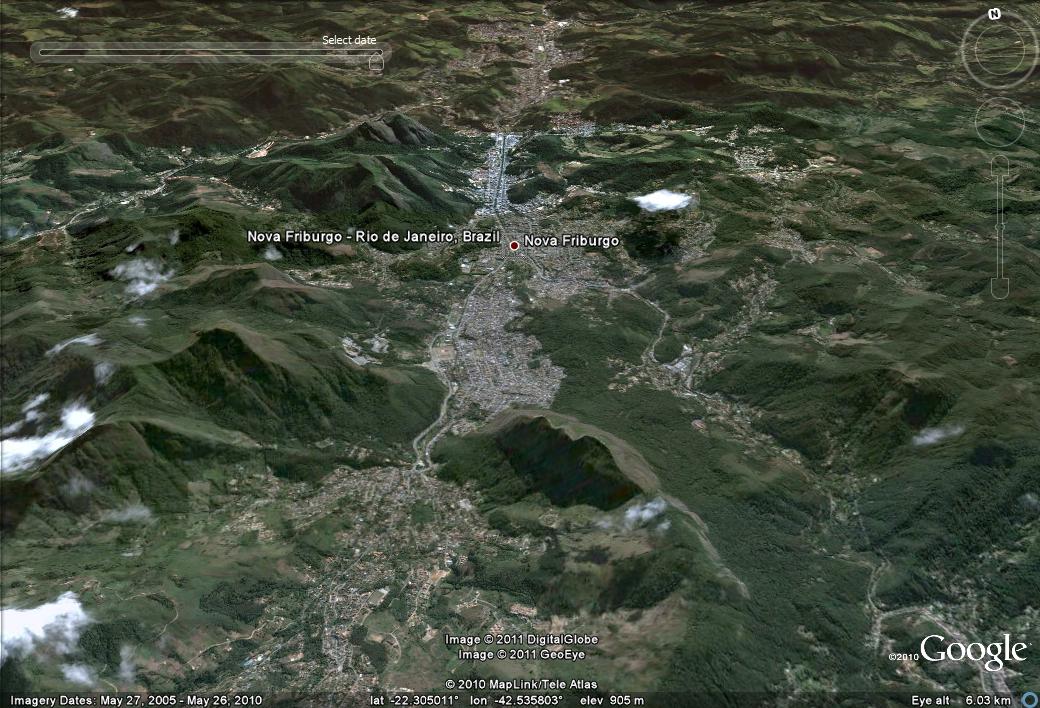
 Dave Petley is the Vice-Chancellor of the University of Hull in the United Kingdom. His blog provides commentary and analysis of landslide events occurring worldwide, including the landslides themselves, latest research, and conferences and meetings.
Dave Petley is the Vice-Chancellor of the University of Hull in the United Kingdom. His blog provides commentary and analysis of landslide events occurring worldwide, including the landslides themselves, latest research, and conferences and meetings.
Thanks for this post, Dave. I was hoping you’d add some landslide perspective to what I’d written earlier this week: http://all-geo.org/highlyallochthonous/2011/01/landslides-and-flooding-in-brazil/. It will be interesting to see what the aerial imagery looks like after this event.
Dr. Petley,
The Boston Globe has put up a collection of images from the Brazil disaster region:
http://www.boston.com/bigpicture/2011/01/landslides_in_brazil.html
Glad you had a chance to post a bit about the disaster in the Rio de Janeiro state mountains, despite your day job duties. From the news reports I have seen, the damage was caused by a wide spectrum from landslides to mud flows to more pure flooding of rivers.
It was interesting to read about that the reason why these landslides are long and narrow. It was very informative.
Dear Dave,
Would these landslides be partly as a result of deforestation or mining activities?
[…] decent satellite imagery of the devastating Brazil landslide disaster has proven to be exceptionally difficult due to the presence of clouds across the affected area. […]
Hello everybody.
I found this blog just today, very good, congratulations.
I’m Brazilian and I live in Nova Friburgo. I want to give you some more information about the landslides.
When it happens I was out of the city, but on the next day I was back and I join the rescue teams for 9 or 10 days (I have a Jeep 4×4, very useful on this kind of situation).
The number of fatalities was very underestimated by Brazilian authorities, I has been in almost every place affected in my city and I can assure you: only in Nova Friburgo we got about 1000 fatalities (looks like the government has counted only identified victims). Hundreds of bodies still buried until today, and will stay buried for ever (thousands and thousands tons of debris and land covering they).
From around the Christmas to the disaster day, we got daily rain, was raining almost all day, every day. Some times little bit heavy rain, but mostly light rain.
On the disaster day, we got really heavy rain (45mm in 2 hours more or less) this heavy rain was falling on a already completely soaked land.
We also had a heavy thunder and lightning storm. Many people told me that their entire houses was shaking with the thunders shock waves. I believe that these thunders and lightnings have an important contribution to the landslides.
We got landslides in degraded lands (deforestation) but we also got landslides in hills and mountains where the forest was never touched.
And what is really getting me concerned is that almost nothing was done since the disaster happens to prevent it to happens again.
We still have people (thousands) living in high risk areas, the vegetation did not covered the landslides sites yet (exposed land) and we still have very unstable places, due the January landslides.
Rain season is quite delayed this year in Brazil, but will commence now (October second half) and will be at the maximum in December / January.
I ‘am afraid a new catastrophe is coming. I hope not.
Antonio,
Thank you so much for contributing your eye-witness account. It really paints a graphic picture of the tragedy that happened to you city.
My condolences to all who lost loved ones.
Ray, thank you for your words.
I realize I gave wrong information about the amount of rain on the disaster day.
The correct is 250mm in 4 hours.
I will keep you updated if something happens on this next rain season.
Regards from Brazil
[…] causing concern about the potential for serious landslides in Brazil, which a year ago caused such remarkably high losses. Reports suggest that a landslide this week killed two people in Ouro Pretodue, and there is […]
[…] Rio de Janeiro in Brazil is a city with significant levels of landslide risk. In April 2010, heavy rainfall triggered a large number of landslides across the city, killing hundreds of people. For example, Nova Friburgo suffered multiple landslide events with catastrophic outcomes:- […]